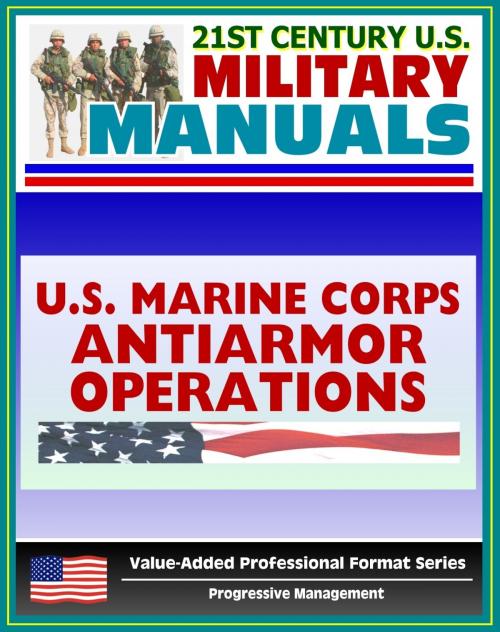21st Century U.S. Military Manuals: Antiarmor Operations Marine Corps Field Manual (Value-Added Professional Format Series)
Nonfiction, History, Military| Author: | Progressive Management | ISBN: | 9781465743145 |
| Publisher: | Progressive Management | Publication: | September 28, 2011 |
| Imprint: | Smashwords Edition | Language: | English |
| Author: | Progressive Management |
| ISBN: | 9781465743145 |
| Publisher: | Progressive Management |
| Publication: | September 28, 2011 |
| Imprint: | Smashwords Edition |
| Language: | English |
Part of our value-added professional format series, the Antiarmor Operations Marine Corps Field Manual sets forth the doctrine, tactics, techniques, and procedures to be employed by a MAGTF commander and subordinate commanders in defensive operations against a mechanized force.
The Marine Corps is an expeditionary force that must be light enough to be strategically projected yet heavy enough to defeat potential adversaries possessing large armored formations. The expeditionary nature of the Marine Corps limits the number of armor assets available to the Marine Air-Ground Task Force (MAGTF), while many of our potential enemies continue to expand and upgrade their armor forces. This dilemma requires that the MAGTF commander adopt a style of warfighting which allows him to win without armor parity.
A MAGTF may confront two types of armor threat. The first is the small group of tanks operating in direct support of enemy infantry. The second type is the large armored force which is the enemy's arm of decision and its primary means of influencing the battle. The destruction of this large armored force is the subject of this manual.
Destroying small groups of tanks is an action that occurs primarily at the small-unit level of war. The destruction of enemy armored formations is primarily a tactical action composed of the many technical actions available to the MAGTF commander. The defeat of large armored formations is not the result of a series of successful, random actions at the platoon and squad level, in which small units utilize supporting arms on an as-required basis. Success against large armored formations requires the proper planning, coordination, and execution from the MAGTF commander down through his subordinate commanders and staffs. This MAGTF focus will ensure the fullest use of combined arms.
As a bonus, this reproduction includes FM-1, The Army Field Manual, a capstone manual containing the vision for the Army - sold separately for $5.99. FM 1 establishes the fundamental principles for employing Landpower. The most important of these are the Army's operational concept and the fundamentals that support it. They form the foundation for all Army doctrine. All Soldiers should understand and internalize them. FM 1 describes the American profession of arms, the Army's place in it, and what it means to be a professional Soldier.
This is a privately authored news service and educational publication of Progressive Management.
Part of our value-added professional format series, the Antiarmor Operations Marine Corps Field Manual sets forth the doctrine, tactics, techniques, and procedures to be employed by a MAGTF commander and subordinate commanders in defensive operations against a mechanized force.
The Marine Corps is an expeditionary force that must be light enough to be strategically projected yet heavy enough to defeat potential adversaries possessing large armored formations. The expeditionary nature of the Marine Corps limits the number of armor assets available to the Marine Air-Ground Task Force (MAGTF), while many of our potential enemies continue to expand and upgrade their armor forces. This dilemma requires that the MAGTF commander adopt a style of warfighting which allows him to win without armor parity.
A MAGTF may confront two types of armor threat. The first is the small group of tanks operating in direct support of enemy infantry. The second type is the large armored force which is the enemy's arm of decision and its primary means of influencing the battle. The destruction of this large armored force is the subject of this manual.
Destroying small groups of tanks is an action that occurs primarily at the small-unit level of war. The destruction of enemy armored formations is primarily a tactical action composed of the many technical actions available to the MAGTF commander. The defeat of large armored formations is not the result of a series of successful, random actions at the platoon and squad level, in which small units utilize supporting arms on an as-required basis. Success against large armored formations requires the proper planning, coordination, and execution from the MAGTF commander down through his subordinate commanders and staffs. This MAGTF focus will ensure the fullest use of combined arms.
As a bonus, this reproduction includes FM-1, The Army Field Manual, a capstone manual containing the vision for the Army - sold separately for $5.99. FM 1 establishes the fundamental principles for employing Landpower. The most important of these are the Army's operational concept and the fundamentals that support it. They form the foundation for all Army doctrine. All Soldiers should understand and internalize them. FM 1 describes the American profession of arms, the Army's place in it, and what it means to be a professional Soldier.
This is a privately authored news service and educational publication of Progressive Management.















